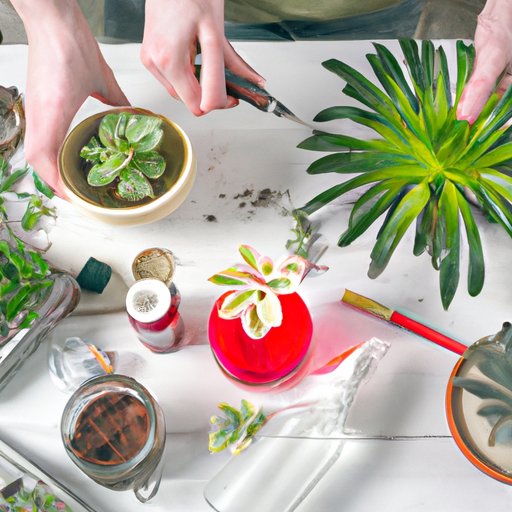
I. Introduction
It’s no secret that succulents have taken the gardening world by storm. These hardy plants come in a variety of shapes and sizes, making them a popular choice for both indoor and outdoor spaces. However, even the most experienced gardeners can encounter problems when attempting to grow succulents. In this article, we’ll provide you with practical solutions to help you care for your succulents like a pro.
II. The Basics of Succulent Care
Before diving into specific problems, it’s essential to understand the basics of how to care for succulents. Succulents are plants that store water in their leaves, making them ideal for dry and arid climates. They require different care than other plants, such as cacti, because of their unique characteristics.
The key factors for successful succulent growth include soil, watering, sunlight, and potting techniques. When it comes to soil, succulents prefer well-draining, gritty soil. Watering is a crucial element of succulent care, as these plants are prone to root rot. Water only when the soil is completely dry, and be sure to water deeply and infrequently rather than shallowly and frequently. Succulents also require bright, indirect sunlight, though some varieties prefer more shade. Finally, proper potting techniques are essential, as succulents need to be planted in pots with drainage holes.
Common mistakes that lead to succulent problems include overwatering, using the wrong soil, not providing enough sunlight, and planting succulents in containers without drainage holes.
III. Troubleshooting Common Succulent Problems
Despite your best efforts, succulent problems can still arise. Overwatering, under-fertilizing, pests, and sunburn are all common issues encountered when growing succulents. Overwatering can lead to root rot, while under-fertilizing can result in stunted growth and faded coloring. Pests, such as mealybugs and spider mites, can quickly spread throughout an entire plant and even to other succulents. Sunburn is another issue that can occur when succulents receive too much direct sunlight, resulting in brown spots on leaves or even scorched plants.
To combat these problems, it’s essential first to identify the issue. For example, if you notice a succulent’s leaves have turned brown, it may be suffering from sunburn. On the other hand, if you see small insects on the plant, it may have a pest infestation. Once the problem is identified, solutions can be tailored accordingly. Prevention tips include using well-draining soil and keeping an eye out for early signs of problems.
IV. DIY Succulent Projects for Indoor and Outdoor Spaces
Succulents aren’t just beautiful plants; they can also be incorporated into a range of DIY projects for both indoor and outdoor spaces. Creating a vertical garden or a miniature succulent arrangement is a great way to add greenery to your home decor. Succulent wreaths are another popular option and can be customized to suit your individual style. Step-by-step instructions and materials can be found online or at your local gardening store.
V. Professional Advice from a Succulent Expert
For the ultimate insight into caring for different types of succulents in different climates, we reached out to a botanist and succulent expert. In a quick Q&A, he shared some valuable tips on optimal succulent growth and health. He also debunked some common misconceptions about succulent care, such as the belief that succulents can thrive in stagnant water. Finally, he emphasized the importance of starting with healthy plants and investing in quality soil and potting techniques.
VI. Succulent Care for Busy People
Balancing a busy schedule with caring for plants can be challenging, but it’s entirely possible with low-maintenance succulent varieties. These plants require minimal watering and can survive for extended periods without attention. Grouping succulents together can also make for easier care and provide a visually pleasing display. Strategies for keeping succulents alive during travel or long work hours include planting them in self-watering pots or leaving them with a trusted friend or neighbor.
VII. Conclusion
Succulent care doesn’t have to be complicated. With the right knowledge and techniques, you can grow healthy and vibrant succulents in no time. Remember the key factors: well-draining soil, infrequent watering, bright, indirect sunlight, and proper potting techniques. Troubleshooting problems involves identifying the issue and providing tailored solutions. Finally, don’t be afraid to get creative with succulent projects and invest in quality plants and products for optimal growth and health.




